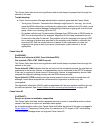
Event Data
Issue 1 June 2005 153
Cause Value 52
[0x34/0xB4] -
Outgoing calls barred
The call could not be completed because the network screened the call, and the calling user is
not permitted to make an outgoing call.
This Cause Value has local significance only. The ISDN network between the user and the
equipment generating the Cause Value might:
● Send no cause indication through the network
● Send a more generic Cause Value through the network
Cause Value 53
[0x35/0xB5] -
Service operation violated (NI-1: National ISDN 1)/
Destination not obtainable (1TR6: AT&T ISDN Protocol)
Cause Value 53 (NI-1) indicates that the user has violated the service operation.
Cause Value 53 (1TR6) indicates that the call cannot be delivered to the remote endpoint
because the interface to the endpoint in not functioning correctly. A signaling message could not
be delivered to the remote device (for example, there is a physical or data link layer failure at
the remote device, or the remote device is turned off).
Cause Value 54
[0x36/0xB6] -
Incoming calls barred
The call could not complete because the called user is not allowed to accept the call delivered in
the SETUP message.
This Cause Value has end-to-end significance and should always be passed back through the
network to the user.
Troubleshooting
● Check Communication Manager administration (network generated the Cause Value).
- Trunk group: Direction: The Communication Manager field might be set to two-way on a
trunk group that the ISDN network has configured as outgoing only, relative to the CO
switch, and a user on Communication Manager is attempting to make an outgoing call
over this trunk group, which is an incoming call to the CO.
- On tandem calls through Communication Manager from ISDN trunks to ISDN trunks, an
NSF for a one-way service (for example, Megacom 800) is being tandemed from one
D-channel to the other D-channel. The problem is that the outgoing trunk group is CBC
but no service or feature was specified on the outgoing route pattern to overwrite the
incoming NSF. Add the correct service or feature to the route pattern or make the
outgoing trunk group a static trunk group (for example, public-network or tie) as
appropriate.


















